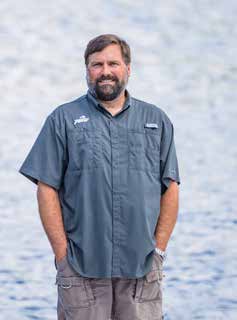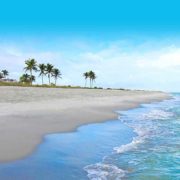The “Fool’s Gold Coast”
 by Dr. Michael Parsons,
by Dr. Michael Parsons,
The Water School, Florida Gulf Coast University
Head east across Alligator Alley, and you’ll end up at what many people refer to as the “Gold Coast” due to the affluence of the area.
Meanwhile, here on the west coast, we’re in danger of becoming the “Fool’s Gold Coast”. Why do I say this? Because of poor water quality.
Over the past several years, benthic (bottom living) fish and invertebrates (like fighting conchs) washed up dead on local beaches, generally when waters began to warm in late spring.
Most recently, thousands of dead fish and crabs washed up on our beaches this past fall. What caused these marine life mortalities?
While red tide was present this past fall, it was not red tide toxins that caused the mortalities of these benthic organisms. Rather, the culprit was hypoxia, or low oxygen conditions, similar to the “Dead Zone” that develops in coastal waters off Louisiana every summer.
Hypoxia in our coastal waters is likely caused bysimilar phenomena as in Louisiana; organic mattersettles on the seafloor and is degraded by bacteria,which consume oxygen in the process. Add in warmwaters – which hold less oxygen and cause an increasein bacterial activity – and you create conditions wherebacteria rapidly deplete the oxygen in the water, leavinglittle or no oxygen for fish and other organisms to“breathe”.
Phytoplankton (microscopic algae in the water) are the primary source of this organic matter, fed by nutrient inputs from the Mississippi River in Louisiana waters, or legacy nutrients from wet season run-off in our waters in spring months.
This past fall, however, red tide provided a deadly “one-two punch” by killing organisms with their toxins, followed by even greater mortalities caused by hypoxia fueled by bacteria breaking down the dead biomass.
We mapped out the hypoxic zone last fall: 800 square miles in area, in which 75% of the water column did not have enough oxygen to support life.
This year, researchers from the Water School at FGCU have deployed sensors to monitor oxygen conditions so that we can develop actions to reduce or prevent these low oxygen conditions in the future.
One interesting side effect of hypoxia in the ocean is that when oxygen is absent from the water, bacteria can harvest oxygen from sulfate (SO4-2),attaching the free sulfur atoms to iron (Fe), creating Ferric Sulfide (FeS2);commonly known as pyrite or “Fool’s Gold”.
I remember participating in research dives in Louisiana coastal waters during hypoxic events and seeing pyrite glittering on the seafloor; quite an eerie and alien experience.
What does this have to do with Naples? WalletHub recently named Naples the top beach town in the United States.
People live and vacation here because of our beautiful environment, including our beaches and coastal waters. Recurrent hypoxia events in our coastal waters is a sign that our coastal ecosystem in unhealthy; there are too many nutrients entering our waters.
We are in danger of destroying the very commodity that supports our local tourism, real estate, and quality of life.
Without meaningful actions to reduce nutrient inputs to our waters, we face the reality of living on a “Fool’s Gold Coast”.




Leave a Reply
Want to join the discussion?Feel free to contribute!